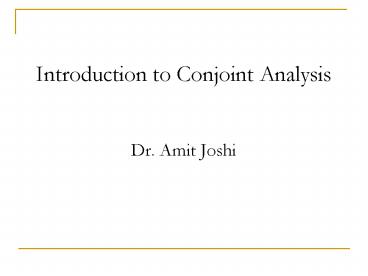Introduction to Conjoint Analysis Dr' Amit Joshi
1 / 16
Title:
Introduction to Conjoint Analysis Dr' Amit Joshi
Description:
Buyers want all of the most desirable features at lowest possible price ... 210 Horsepower or 140 Horsepower. 17 MPG 28 MPG. If choose left, you prefer Power. ... –
Number of Views:137
Avg rating:3.0/5.0
Title: Introduction to Conjoint Analysis Dr' Amit Joshi
1
Introduction to Conjoint AnalysisDr. Amit
Joshi
2
Different Perspectives, Different Goals
- Buyers want all of the most desirable features at
lowest possible price - Sellers want to maximize profits by 1)
minimizing costs of providing features 2)
providing products that offer greater overall
value than the competition
3
Attributes and Levels of a Product
4
Buyers Want!
5
Sellers Want!
The answer is in between! But where?
Conjoint enables us to figure out the customer
preferences first and then build the product
accordingly!
6
What is Conjoint Analysis?
- Life is about trade-offs. Conjoint is a way to
learn how people make trade-offs when confronted
with different features. - Mimics the real world we show people products
and let them tell us how much they like them. - We vary the features of the product and quantify
how aspects of the product drive preference. - Assumption of Conjoint The value (utility) of
the product is equal to the sum of its parts
(attributes) - Computer (Brand) (Processor Speed) (RAM)
(Monitor) (Price) - Credit Card Brand Interest Rate Annual Fee
Credit Limit
7
Background What is Conjoint? (cont.)
- The attributes we measure must be levelable
- Brand Dell, Compaq, IBM
- Processor Speed 2 GHz, 3 GHz
- RAM 512 Mb, 1 Gb, 2 Gb
- Price 700, 1,000, 15,00
- If we learn how much value (utility) people have
for each of these levels, we can add them up and
predict how much they would like potential PCs we
could present - Hypothetical Utilities for
an Individual - Computer (Dell) (3 GHz) (1 Gb RAM)
(1,000) - (45) (5) (10)
(5) (25)
8
How to Learn What Customers Want?
- Ask Direct Questions about preference (Answers
often trivial (e.g. respondents prefer low fees
to high fees, higher credit limits to low credit
limits) - What brand do you prefer?
- What Interest Rate would you like?
- What Annual Fee would you like?
- What Credit Limit would you like?
- Ask Direct Questions about importance of the
attribute! - How important is it that you get the (brand,
interest rate, annual fee, credit limit) that you
want?
9
Stated Importance
- Importance Ratings often have low discrimination
Not very actionable!
10
How Does Conjoint Analysis Work?
- We vary the product features (independent
variables) to build many (usually 12 or more)
product concepts - Marketers catch-phrase-- Features CONsidered
JOINTly - We ask respondents to rate/rank those product
concepts (dependent variable) - Based on the respondents evaluations of the
product concepts, we figure out how much unique
value (utility) each of the features added - (Regress dependent variable on independent
variables betas equal part worth utilities.)
11
Whats So Good about Conjoint?
- More realistic questions
Would you prefer . . . - 210 Horsepower or 140
Horsepower17 MPG
28 MPG - If choose left, you prefer Power. If choose
right, you prefer Fuel Economy - When respondents are forced to make difficult
tradeoffs, we learn what they truly value
12
Conjoint is done at an individual level first!
13
Conjoint Utilities (An Illustrative Example)
- Numeric values that reflect how desirable
different features areFeature Utility - Vanilla 2.5Chocolate 1.825 5.335 3.25
0 1.4 - The higher the utility, the better
14
Attribute Importance
- Measure of how much influence each attribute has
on peoples choices - Best minus worst level of each attribute,
expressed in percentage termsVanilla -
Chocolate (2.5 - 1.8) 0.7 15.225 -
50 (5.3 - 1.4) 3.9 84.8 ----- -------
- Total 4.6 100.0
15
Market Simulation Example
- Predict market shares for 35 Vanilla cone vs.
25 Chocolate cone for Respondent 1Vanilla
(2.5) 35 (3.2) 5.7Chocolate (1.8) 25
(5.3) 7.1 - Respondent 1 chooses 25 Chocolate cone!
- Repeat for rest of respondents. . .
16
Market Simulation Results
- Predict responses for 500 respondents, and we
might see shares of preference like - 65 of respondents prefer the 25 Chocolate cone































